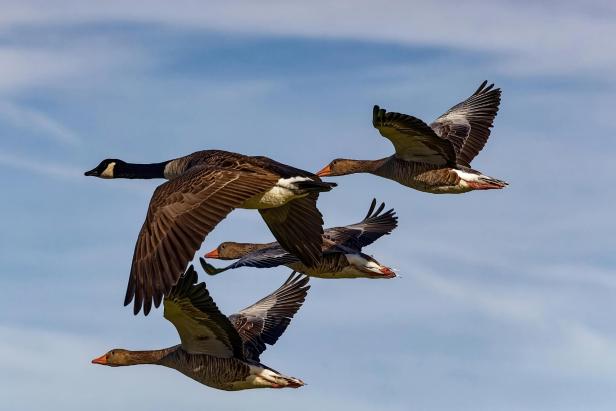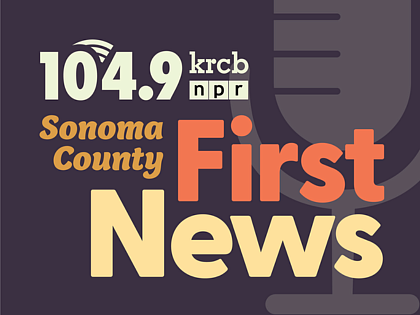 photo credit: Shutterstock
photo credit: ShutterstockOne way commercial poultry contracts avian flu is via contact with wild migratory bird
populations.
The newsroom set out to look more closely at various statements made by both sides during the debate.
Greta Mart: As Sonoma County voters make their decisions in the final days leading up to the Nov. 5 election, we are presenting our listeners a final summary of what we’ve heard in our reporting on Measure J, to help inform our community on this contentious topic.
I’m here with KRCB’s Noah Abrams. Measure J asks voters: should Sonoma County ban concentrated animal feeding operations, known as CAFOs.
Greta Mart: Noah, let's start by talking about HPAI...
Noah Abrams: Yeah, highly pathogenic avian influenza, to give it its full name, it's been making a really big impact on different animal ag facilities both in Sonoma County and across California.
How about we throw it over to a clip from the debate, and then we can talk more about HPAI. Here's Lewis Bernier...
Lewis Bernier: We saw recently in Sonoma County, the highly pathogenic avian influenza that infected over a million birds, and it jumped CAFO to CAFO to CAFO across the county. And when HPAI, when avian flu, hits a CAFO, compared to a small farm, that's 500,000 egg laying hens that are immediately euthanized instead of a smaller number for a smaller farm.
Noah Abrams: So, basic timeline, about two years ago, backyard flocks in Sonoma County contract HPAI-avian flu, which often originates with wild birds moving on the Pacific Flyway...then, holiday time last year, when some 500,000 plus wild birds were estimated to be moving through the county per night, we get a cascade of infections at different poultry facilities, mostly clustered west of Petaluma, starting with a duck farm.
Sonoma County actually declared a local emergency because of the HPAI outbreaks - they hit 10 different sites, some egg laying, and some meat raising - and the infections resulted in multiple culls totaling about a million birds.
Greta Mart: The numbers are immense.
Noah Abrams: Yeah, a really unfortunate situation. State investigators looked into the outbreak here and while they couldn't say definitively what caused it, they identified a number of potential biosecurity failures that might've introduced the virus into the flocks.
Greta Mart: What were they?
Noah Abrams: A shared ranch manager for different sites, cohabitating employees, offsite egg processing, and facility intrusions by animal rights activists - again, the report stresses that they could not pinpoint a definitive cause. But I think the big takeaway, and one that is noted in the report, biosecurity protocols are only as strong as they're practiced...lax biosecurity measures can have catastrophic results.
Greta Mart: And there's been a concerning growth in HPAI infections outside Sonoma County recently right?
Noah Abrams: Yes, I spoke with Dr. Juergen Richt, he's an expert in emerging zoonotic and animal diseases, about the recent spread of HPAI to cows and humans
Juergen Richt: We have more than 300 cases of bovine influenzal; more than 300 dairy farms are infected in this country. And one third of these were found in the Central Valley of California. And we have, I believe, almost 20 confirmed cases, human cases with H5N1. But some of them are from poultry operations and some of them are from dairy operations.
Greta Mart: So we're now seeing cases of avian flu infecting cows and humans?
Noah Abrams: Yes, not in Sonoma County thankfully. Here’s Dr. Richt again:
Juergen Richt: With dairy cattle…what's happening here? It's not that they get infected by a bird at this time. There was only one introduction as far as we know in the United States, in a farm in Texas, in the panhandle of Texas. And that's where the whole thing started. And then from there, animals were shipped throughout different states and these animals were sick or sub clinically ill, and people didn't recognize that. And so that's how the virus got spread around the country. And we believe now from our data that the spread of the virus is not like a regular flu virus, which spreads by aerosols and droplets. This is spread mainly by milk and by human activities.
Noah Abrams: So with so many points of contact throughout the animal agriculture system and supply chain, there's lots of opportunity for infection cascades like we're seeing in the Central Valley.
Greta Mart: Let's go back now to a clip from the debate, again, here's Bernier:
Lewis Bernier: The Purdue slaughterhouse in Petaluma has four times the national rate of Campylobacter and more than four times the statewide rate of salmonella, and that has been sustained over a very long period of time.
Noah Abrams: So according to reporting in the Press Democrat, Purdue's slaughterhouse in Petaluma - which is the largest in the county, and the only one large enough to receive federal inspections - has clocked higher rates of salmonella and camplyobacter - both are bacteria which can cause food borne illness. Also it should be noted, that report was from two years ago, and no illness outbreaks have been tied to the facility despite those elevated testing levels.
I think the important conclusion to draw is that our food system is full of moving parts, and that means robust biosecurity, and robust inspections are crucial, I mean we see it with the listeria outbreak from Boar's Head products, a lack of oversight and good practices can be fatal.
And when I think about the avian flu outbreaks here in Sonoma County, we're very lucky that they were contained with swift action, but it came at great cost to the businesses involved, and to the nearly one million birds who were killed to halt the spread of the virus.
Greta Mart: Thank you, Noah, we will next look at Measure J and animal welfare.

 Live Radio
Live Radio




